
by Regan Bervar | Apr 23, 2021 | Glendale City News
“The world is divided into armed camps ready to commit genocide just because we can’t agree on whose fairy tales to believe.” — Ed Krebs
 by Luke Schmaltz
by Luke Schmaltz
Daniel Woldu is a resident of Aurora, Colo., and a member of the international Tigray community. He has family members living in the Tigray region of northern Ethiopia. He watches in horror as online CNN footage (leaked from a soldier-turned-whistleblower) shows a military squadron slaughtering his ethnic peers in illegal extrajudicial executions. He is witnessing the genocide of his people — which is concurrently taking place.

Stateside demonstrations raise awareness of a humanitarian crisis. Photo by Endale Getahun
Woldu is becoming increasingly distressed, as a member of his immediate family traveled to the Tigray region in early September. The region has since been invaded by its own country’s army — an initiative ordered by Ethiopian Prime Minister Abiy Ahmed. As a result, all communication was completely disabled. Although some telephone service has recently been restored, Woldu endures long stretches of worry — not knowing the fate or whereabouts of his gravely endangered family member. (Identity withheld at Mr. Woldu’s request). Speaking for his Tigray community at large, Woldu explains, “This is something the majority of our community members are facing. They have family members who are stranded and it’s hard to know their whereabouts or even if they are still alive or not.”
The Walls Close In
On November 4, 2020, while the rest of the world was fixated on the results of the U.S. election, the invasion of Tigray went largely unnoticed. The initiative began by blocking the main conduit of goods, services and commerce into the region and by cutting off all telephone and internet connections and shutting down the electrical grid. The Ethiopian National Defense Forces were then deployed along with aerial bombardments. Abiy declared the campaign was a “law and order” operation against domestic terrorists. Yet, the atrocities being committed by Abiy’s forces — which reports confirm as weaponized rape and indiscriminate murder — did not come to light until they were brought to the fore by Amnesty International. To make matters worse, the campaign has been joined by troops from the northern neighboring country of Eritrea, who are acting in allegiance with Abiy’s federal troops. To further complicate matters, Tigray is in an ongoing retributive dispute with militias from the western bordering region of Amhara, who are attempting to annex Tigrayan territories. Essentially, Tigray is surrounded on all sides.
Ulterior Motives

Ethiopian Americans of Denver show their support for their families in Tigray. Photo by Endale Getahun
Although Abiy’s campaign was presented to the global community as a peacekeeping necessity, it is largely recognized that the invasion was a result of long-simmering tensions between Ethiopia’s federal government and the regional government of Tigray. While the conflict is taking place on the other side of the globe, it is having a profound effect on many stateside communities. One such community is the Ethiopian populace of the Denver/Aurora region which includes around 30,000 residents — some foreign born and others first-generation Americans. A small segment of this community identifies as Tigrayan, which is ethnically distinct from other Ethiopian communities. This dynamic makes matters worse for people like Daniel Woldu, as long-held tensions between ethnicities driven by religious differences and cultural bias are being reignited by the conflict in Ethiopia and carried out in American communities. Woldu explains. “Abiy’s propaganda is so that the general population does not feel bad for being complicit with genocide.”
To The Streets

War-torn Tigray region of Ethiopia hits home with Denver/Aurora residents.
For this reason, members of the Tigray community in Colorado and in cities across the nation have taken to staging protests. Their mission is to spread awareness of the humanitarian crisis and to put pressure on American authorities to take action and stop the ongoing genocide of their people. Peaceful protests are taking pace in Washington, D.C., Denver, Los Angeles, New York City, Louisville, Las Vegas, and many others. Multiple marches on Colorado’s State Capitol as well as candlelight vigils at area religious centers are bringing the local Tigray community together, but so far, they have not swayed local officials to appeal to their counterparts in Washington to intervene. The overarching concern of the citizens is that Ethiopian federal troops are not allowing the United Nations into the region to provide humanitarian support to refugees, many of whom they are related to. While this is having some influence, activists like Daniel Woldu are painfully aware that it is not enough. “While they [U.S. Government] have put demands out there,” he says, “they have not been able to stop the [Ethiopian] military.”
To The Airwaves

Denver’s Endale Getahun broadcasts the ongoing crisis in his home country.
Among members of the Denver/Aurora Ethiopian community, journalist Endale Getahun is working overtime reporting the events in Tigray as well as the ongoing protests in communities across the United States. Getahun broadcasts via Ethiopian Community Television and radio station KETO 93.9 FM. He explains that not all stateside Ethiopians are sympathetic to Tigray. “The majority of Ethiopians do not have sympathy for Tigrayans due to predisposed bias,” he says. Getahun also makes a clear distinction between Abiy’s propaganda, his claimed intentions and the subsequent actions of his military campaign. “When the government of Ethiopia launched the attack — to convince the general population — they said Tigrayan insurgents had attacked the military base in Tigray where the federal troops were stationed. But those troops have been there for 20-plus years — some of them are married to Tigrayans — so that was just an excuse.” He explains. “And now, since the power, communications and internet have been down, a lot of loved ones, a lot of people around the world, cannot reach their families, send money, food or medicine. Instead of apprehending the local [Tigrayan] leadership like they said they were going to do, they are trying to wipe out the whole Tigrayan population.”
The War At Home
Meanwhile, Daniel Woldu is still hopeful that his stranded family member can somehow, by some means, make it out of war-torn Tigray and back home to Colorado. “[They] are scared to travel because of what might happen.” he says. “Who knows, they may be one of the unlucky ones who steps out the door and is met by Eritrean troops.”
Woldu and others have met with local representatives to voice their concerns. “We’ve had conversations, as a community, with our congressman — Jason Crow — but those are just conversations. There are no actions behind them,” he explains. “The problem is that there are other Ethiopians in our community who are saying ‘you have to stay away from internal problems in Ethiopia.’ There is a genocide going on and they are advocating that the U.S. should not take any action.” Woldu cites the ongoing divide between Ethiopian ethnicities and how the Tigray people are just 7% of the country’s total population, which is reflected in Ethiopian communities the world over.
Daniel Woldu is also a member of Omna Tigray — a national organization of young professionals dedicated to spreading awareness of the humanitarian crisis affecting the Tigray people (omnatigray.org).
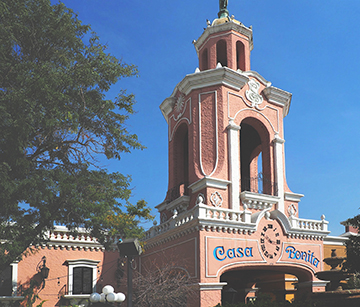
by Regan Bervar | Apr 23, 2021 | Main Articles
“An old building is like a show. You smell the soul of an old building. And the building tells you how to redo it.” – Cameron Mackintosh
 by Luke Schmaltz
by Luke Schmaltz
Casa Bonita stands shuttered alongside West Colfax like a circus gelding locked in a corral for which there is no key. First opened in 1974, the one-of-a-kind survivor from a bygone era is a testament to the optimism, pageantry and imagination of the previous century. But alas, it is currently silent as a result of COVID-19.

The Pink Palace is in the red. This 85-foot, 22-karat-gold domed tower can be seen for miles around.
As it was for most other Colorado restaurants, the mandatory order to close in March of 2020 was a crippling blow. Rather than partially reopen in May of 2020, Casa Bonita management chose to forgo the near-impossible strictures that social distancing would have placed on an entertainment concept built on human interaction.
Finally, more than a year later, there are rumblings of reopening — and a notice on the restaurant’s website confirms these murmurs. Yet, if there’s anything the last year has taught people, it is to not believe everything you read online. This is why a group of Denver residents and longtime natives who have lasting memories of this cherished institution are not going to take the possible death of fun sitting down.
Locals To The Rescue
Savecasabonita.org is a recently-launched initiative intent on spreading awareness of the cultural and historical importance of 52,000-square-foot restaurant, Casa Bonita. Led by Denver icon and Casa Bonita superfan Andrew Novick, this collective of innovators and entrepreneurs represents a larger segment of the Mile High populace that feels this beloved destination deserves another chance. “We have a large group of people in our consortium,” Novick begins. “The group we put together is made up of restaurateurs, folks who have built businesses from the ground up and branding experts. One of our people is a Latina businesswoman and we’ve talked a lot about the food and the cultural appropriation of Casa Bonita. The last thing we want to do is be a bunch of white men running a Mexican restaurant.”

Proponents don’t want Casa Bonita to suffer the fate of The Miner in Black Bart’s Cave. Photo by Andrew Novick
An Unforgettable Experience
For those who have never been there, a visit to Casa Bonita is an immersion into experiential art, culture, kitsch and otherworldly wonder. It’s an escapade into a circus-like realm of cliff divers, puppeteers, gunfighters, family photos, cave adventures, arcade overindulgence and a hype man in a gorilla suit. And yes, there’s the Mexican fare, which can leave a bit to be desired at times, but the meals always finish strong with delectable honey-soaked sopapillas. “It’s always been about the experience, not the food.” Novick explains. “I mean, how many restaurants last for [almost] 50 years?”
Money Talks
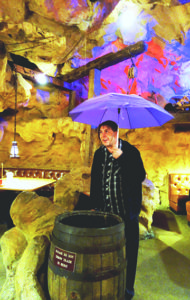
Andrew Novick is Casa Bonita’s #1 fan. Photo by Jerilee Bennett.
Rather than attempt to influence the owners of Casa Bonita via community petition, Novick and his associates chose to start a GoFundMe campaign, as a monetary donation signifies a greater commitment than just a signature. With a goal of $100,000, the fund is quickly gaining steam and, at the time of this writing, sits at nearly half of the way in just three weeks. Novick is quick to point out that the money is not intended to pay any current debts the restaurant’s parent company may have outstanding. Rather, the funds would serve as a capital-bolstered basis for participating in the conversation about the future of the restaurant. Novick explains, “We are fundraising to have the power to have a voice in the conversation.” This could play out in any number of ways, from funding a PR campaign to advertise a grand re-opening to procuring legal counsel to broker a deal between the current owners and potential new investors.
A Wild Ride

Casa Bonita’s centerpiece, 30-foot-tall indoor waterfall is modeled after the cliffs of Acapulco and pumps 26,427,000 gallons of water per year, which supplies its 14-foot-deep pool into which cliff divers and actors plunge during the shows.
Understanding the history of the Casa Bonita ownership can be as overwhelming as a visitor’s first foray into Black Bart’s Cave. Initially, it was one component in a chain of themed restaurants that began in Oklahoma City, and branched out to Tulsa, Okla.; Little Rock, Ark.; Fort Worth, Texas; and Lakewood, Colo. The chain was the brainchild of artist, innovator and business mogul Bill Waugh, who was responsible for numerous spectacles of themed entertainment including the Crystal’s Pizza and Taco Bueno chains. In 1982, Waugh sold his company to Unigate, who, in 1992, sold it to CKE restaurants (owners of Carl’s Jr.) who then created a spin-off company in 1997 for the two remaining locations. Today, that company is known as Summit Family Restaurants which is a subsidiary of Star Buffet. When it comes to a discussion about the current state of affairs at the Pink Palace, however, no one at either entity is currently available for comment.
Stay Positive
Meanwhile, Novick and company are holding out for a positive outcome wherein the company culture is modernized, the menu is updated and the Casa Bonita fun machine gets jump started back into action. “We want to make sure that in the future, we (savecasabonita.org) are an important voice,” Novick says. “Whether someone else procures it or if they reopen, we want them to know we are the voice of the community and the fans. The funds we generate could be used to create awareness of the reopening and to revitalize the work environment for employees.” An electrical engineer by trade, Novick is also a realist. Concerning a scenario where the funds raised by savecasabonita.org do not afford them a seat at the negotiation table to have their voice heard by the owners or future buyers, he clarifies, “I want to point out that should the funds not be put to use, all donations will be immediately returned to the donors.”
Dream On

Casa Bonita is a Landmark of the Lakewood Historical Society.
As far as procurement of the intellectual property and the business model goes, just like any dedicated Casa Bonita regular, Novick and company are also dreamers. Ideally, Trey Parker and Matt Stone (creators of South Park) would swoop in, buy out Star Buffet, and entrust the locals to run the zoo. The duo made Casa Bonita a worldwide household name in a 2004 South Park episode which prominently featured the restaurant in all of its fantastically ridiculous glory. In this “everyone wins” scenario Novick, who celebrated his 300th visit to Casa Bonita in 2019 with a wildly successful charity event, could play an integral role. “I’ve done food events, experiential events and experiential art,” he explains. “I feel my role could be VP of experience.”
For now, however, the reality of the situation is that a huge piece of Denver history and yet another beacon of the soul of the city is at stake. Star Buffet filed for Chapter 11 bankruptcy on April 6, 2021. So, the harsh fact of the matter is that currently, it’s all about money.

by Regan Bervar | Apr 23, 2021 | Travel
 By Luke Schmaltz
By Luke Schmaltz
At this time last year, if you were to offer someone a set of guidelines for maintaining mental stability, you’d probably get a well-deserved smack in the mouth.
Now that circumstances are settling into a cautious clip toward not crazy, some folks are hoping to reclaim their sense of sanity.
There are simple steps you can take to stop the negative internal chatter, calm your mind and exact some mental clarity so that you can enjoy yourself when you get a chance. Also, an approach with reasonable expectations may be better than a strict regimen for the simple fact that you shouldn’t be stressed out about trying to relieve mental stress. Here are a few strategies to consider based on simplicity of the activity, scientific research, and quantifiable results.
Move Yourself
 In May of 2019, research fellow Karmel Choi, of the Harvard T.H. Chan School of Public Health, published a study on the causal connection between physical activity and depression. The study used Mendelian randomization to assess the genetic data of hundreds of thousands of people from two large databases. The finding offered measurable proof that movement does indeed protect against depression more so than the notion that depression makes you move less. Movement means just that; not fancy exercise, (although that won’t hurt) just the simple act of getting up off the couch and going for a walk, mowing the lawn, doing the laundry, dusting off the blinds and yeah — maybe a few jumping jacks.
In May of 2019, research fellow Karmel Choi, of the Harvard T.H. Chan School of Public Health, published a study on the causal connection between physical activity and depression. The study used Mendelian randomization to assess the genetic data of hundreds of thousands of people from two large databases. The finding offered measurable proof that movement does indeed protect against depression more so than the notion that depression makes you move less. Movement means just that; not fancy exercise, (although that won’t hurt) just the simple act of getting up off the couch and going for a walk, mowing the lawn, doing the laundry, dusting off the blinds and yeah — maybe a few jumping jacks.
Reach Out
A 2014 report issued by the National Institute of Health (NIH) presented research on the effects of loneliness on psychiatric disorders and physical health. The study defined loneliness not as a condition caused by being alone, but rather by being “without some definite needed relationship or set of relationships.” The evidence presented links loneliness to a litany of mental conditions including depression, Alzheimer’s, and alcoholism, as well as physical maladies such as low-grade peripheral inflammation which can lead to a host of other serious conditions. The simple act of speaking regularly with friends and family with whom you have a genuine connection can assuage loneliness. Community and religious leaders can also lend a caring ear, while volunteering with charity organizations or adopting a pet can be workable options as well. Plus there are free support outlets such as The Lonely Hour Podcast, the Daily Strength networking service, the National Suicide Prevention Line and many more.
Log Off

Loneliness has a major impact on mental health.
Most people, regardless of age, can grasp the fact that scrolling through your Twitter feed for hours on end is not the equivalent of reading, does not replace human interaction and does not stimulate critical thinking. Regardless, according to statistica.com, the average person worldwide spent 145 minutes a day on social media in both 2019 and 2020. A recent study by Cureus, which was published by the National Institutes of Health, presented evidence gleaned from 28 scholarly articles on the effect of social media on mental health. Anxiety and depression were found to be the most com-
mon disorders linked to habitual social media use, and that these conditions were heightened in females and passive users who only read and do not post. Thankfully, you have many modern decades of human behavior to fall back on when deciding how to better spend your time. For starters, try points one and two above, then you can listen to a podcast, try a new recipe, read a book, write a book, go to a museum, or take a swim. The possibilities are more endless than your daily Facebook news feed.
Be Generous

It is mentally healthy to be generous.
Just about everyone has heard the old saying, “It’s better to give than to receive.” If there was ever any gravitas to the notion that cliches exist for a reason, this one sets the gold standard. In 2013, the American Public Health Association published a study with the NIH which tested the hypothesis that “providing help to others predicts a reduced association between stress and mortality.” Plainly put, being generous toward others helps you relax and live longer. The study followed subjects over a period of five years and measured stressful events in tandem with giving behavior and death rates. The results showed that stress had no bearing on heart rates of those who were giving to others, yet those exhibiting non-giving behavior had a far more predictable rate of mortality in relation to stressful events. Giving behavior does not mean you have to hand out 10 dollar bills to everyone you meet. On the contrary, most folks would rather have something intangible but far more valuable such as your time, your care, your ear, your attention, or your love.
Call A Truce

Solvent relationships are key to mental health.
In this combative, divisive, and litigious day and age, it seems that folks are predisposed to argue at the drop of a hat and be at odds with one another just for the sake of creating conflict. Perhaps one of the greatest things you can do for your mental wellbeing is to relieve yourself of the burden of always having to be right. Debating important issues and standing up for yourself are, of course, pursuits to be valued. Yet, the law of diminishing returns comes into effect when people actively cultivate conflict, exhibit hostility and seek out arguments — especially with their partners. A 2018 study by the Institute for Behavioral Medicine Research at Ohio State University found that couples who argue frequently are prone to leaky gut, which can lead to all sorts of health problems. Further, a 2020 study published by Oxford Academic on depression and family arguments presented evidence that “ … family arguments put depressed men and women at risk for more severe depressive symptoms.” Since it takes two to tangle, when someone wants to argue about something that truly doesn’t matter, you can agree to disagree, take the high road and relent, or simply disengage and walk away.
by Regan Bervar | Apr 12, 2021 | Uncategorized
“This is not elective surgery. The Mall is falling apart.” — Mark Sidell, President of Gart Properties, Downtown Denver
 by Luke Schmaltz
by Luke Schmaltz
The Mile High City’s pride and joy of walkable, large-scale retail commerce is showing its age. This project has been in the discussion and planning phases for at least 10 years, and now, a collective of developers and government agencies have aligned in unanimous agreement that the 16th Street Mall needs an overhaul.
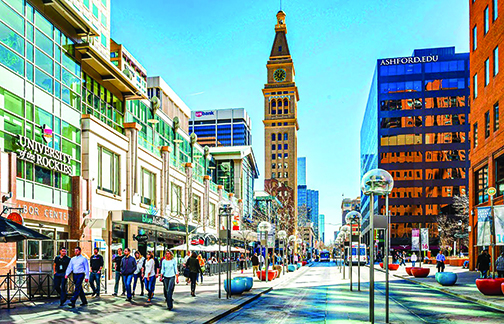
16th Street: Denver’s 16th Street Mall sees incredible foot traffic that has worn it down after nearly 40 years.
This coalescence of groups (primarily) involves the Department of Transportation and Infrastructure (DOTI), Denver Urban Renewal Authority (DORA), the Federal Transit Authority (FTA) and the Downtown Denver Partnership.
The 1.2-mile stretch of walkable commerce and free transport via the RTD MallRide was first opened in 1982. In its inception, the installation was hailed as an unprecedented milestone in urban renewal. The accessible design and pedestrian-friendly layout brought much needed revitalization to a historic yet dilapidated district of run-down tenements, boarded-up warehouses and a pervading sense of imminent danger. While the design has more than served its purpose, wear and tear and the ever-shifting tide of social trends have made it clear that it’s time to streamline the layout for a more user-friendly look and feel.
A Popular Destination
The Downtown Denver Partnership reports (in recent years, pandemic notwithstanding) the 16th Street Mall sees an average of 20,000 pedestrians per day. Meanwhile, the RTD MallRide carries anywhere between 25,000 and 39,000 passengers per day. This sort of traffic takes its toll, as the signature granite pavers used to give the mall its distinctive look must be replaced frequently. This creates an economic strain of around $1 million per year across 75 or so days of maintenance. These large stone blocks were originally rated for a 30-year lifespan underfoot, so many of them have outstayed their tenure.
Streamlining Transit
The prevailing feature the redesign addresses is the areas between the RTD buses which travel up and down the mall at regular intervals
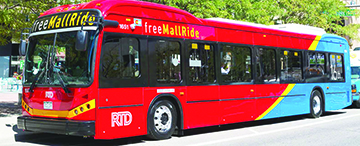
MallRide: The RTD Free MallRide transit bus lanes will be consolidated to create more sidewalk room.
, especially the six-foot stretch between Broadway and Tremont and the 14-foot stretch between Tremont and Arapahoe. With particular reference to the latter measurement, this no-man’s land of abandoned chess tables, exhaust-choked planters and mumbling stumblebums used to be a quaint space for gathering, enjoying shade and sitting down for a rest between shopping sessions.
Due to the increasing frequency of MallRide traffic, these “between zones” have been relegated to underused areas rather than celebrated gathering spaces. It has also been unanimously concluded that, by placing the RTD transit lanes in proximity side by side, a much larger pedestrian sidewalk area can be created. This will reduce congestion, increase foot traffic volume and potentially boost commerce in the long run.
Mark Sidell, President of Gart Properties, which includes the Denver Pavilions and several dozen retail spaces on the mall, sees

Spearheading: The Denver Department of Transportation and Infrastructure is spearheading the Mall’s improvement project.
the project as a design upgrade that will offer an attractive array of benefits and opportunities. “Think of the mall as one big hallway,” he begins. “The redesign will transform it to a hallway with a living room on either side.” Sidell is referring to some of the as-yet undivulged design ideas which will include gathering spaces, performance areas, extended patio zones for restaurants and bars, and places for retail kiosks. In essence, consolidating the RTD MallRides in the “between zones” is going to make a world of difference.
Out With The Old
In terms of infrastructure, the proposed improvements will address and correct several long-standing issues. First, a 200+ year-old drainage system will be replaced with modern engineering, new trees will be planted along either stretch of sidewalk and new pavers will be installed up and down the entire length of the street in a pattern similar to the current design.
On January 21st of this year, the City of Denver announced it had selected PCL Construction to design and build the new 16th Street Mall. In a recent press release, Eulois Cleckley, Executive Director of DOTI, stated, “We’re thrilled to have reached this latest milestone on this landmark project that improves safety and mobility along the mall and attracts commuters and visitors with interesting new spaces and places for people to enjoy. The contract we present to Council in the coming weeks will reflect a decade of planning and recent input from groups representing business owners, workers, community members and people with disabilities.”
The aforementioned news item also states the project is slated to get underway “… in late 2021 and be completed by the end of 2024.” While the long-term benefits of the remodel are numerous and

PCL: PCL Construction is a familiar presence in the Denver area, and will be the main reconstruction contractor.
far-reaching, the City promises a swath of immediate economic stimulus-like benefits that will counteract the Covid-19-induced recession. These include nearly 1,500 jobs for trades apprentices and skilled laborers, $107M in labor income, $261M in sales (for building materials) and an across-the-board bolstering of the Gross Regional Product (GRP) by some $3.7B.
What Does It All Mean?
While these numbers look great on paper, the big question on everyone’s mind — especially local business owners, service industry workers, retail workers, restaurateurs and patrons — is how will this affect business between the beginning of the project in late 2021 to its projected completion sometime in 2024? Sidell expounds on his understanding of the role the contractor will play during construction; “PCL is charged with always keeping the pedestrian traffic open. You’ll always be able to get through whether you are walking by yourself or with a group and it will be ADA (Americans with Disabilities Act) accessible and I am confident that they will do that,” he explains. “All that said,” Sidell continues, “are you going to want that [construction] in front of your place of business even one day longer than it has to be? No, of course not. However, it is construction that is going to be conducted in a way that has been very thoughtfully planned out. They have placed a high priority on maintaining access, safety, signage and keeping businesses open.”
A transparent approach has been orchestrated through a series of meetings between project planners and local retailers, property owners, restaurants and the general public. “They’ve done a great job of getting a lot of public interest into the project because everybody has a different perspective and it’s important to get the input of all mall users.” He says. “I am pretty optimistic about what the other side will be … I am confident that a lot of really smart people are working on it, but I’m a realist — it’s still construction.”
The Show Must Go On
Construction in public areas almost always means detours, and this project is no exception. Julie Smith, Director of Communications for the City of Denver Department of Finance explains, “The Free MallRide shuttle will continue to serve the Mall area throughout construction. In active construction zones, the MallRide will be detoured to 15th or 17th (depending on the direction) which both have dedicated bus lanes which can accommodate the MallRide’s frequent stops without disruption to other vehicular traffic. Also, the RTD MallRide will operate on the Mall normally for the blocks that are not under active construction.”
Her office assures that business and leisure on the mall will still be underway throughout construction. She states, “Mai

Baskets: Cindy Kent of A la Carte Flowers and Baskets is determined to weather yet another storm.
ntaining continuity and predictability for the traveling public during construction is extremely important to the project. As the contractor moves from design into construction, we have a systematic process in place to control the construction work and minimize the overall impact to the community. Safe, pedestrian access to businesses and residences will be maintained throughout the project.”
Through Thick And Thin
Meanwhile in the Mall’s private business sector, Cindy Kent is the owner of A la Carte Flowers and Baskets and she is persevering through a year that has put many of her neighbors out of business. When asked about how she thinks construction will affect businesses on the mall, she responds with the exuberant laugh of a business owner who has a healthy sense of skepticism. “The biggest challenge on the Mall right now is parking,” she begins. “I have a paid parking spot because it is an absolute necessity. But my drivers are constantly looking for parking, so construction is going to no doubt drive my rates up.”
A former member of the Downtown Denver Partnership, Kent explains, “I have been hearing rumors of this project for the 20 years I’ve been in this location” (910 16th Street Mall #312). “It’s not egregious enough that we just went through what we went through,” she continues, “We are on the heels of barely coming back in the fourth fiscal quarter and this is their timing?” Regardless, Kent’s 25th anniversary of being in business is coming up, and she’s as determined as ever to weather yet another large-scale disruption. “I get that is finally underway,” she quips, “But I’m really just rolling my eyes at this point.”
by Regan Bervar | Apr 12, 2021 | Uncategorized
- “From the greatest of horrors irony is seldom absent.” P. Lovecraft
 by Luke Schmaltz
by Luke Schmaltz
Irony’s flag flies at full mast at the Suncor Energy refinery in Commerce City, Colo. The industrial behemoth is located just north of Denver’s city center and just east of the confluence of I-70 and I-270. The company bears a name that conjures images of an eco-friendly solar energy entity — perhaps working to reduce carbon emissions by developing sustainable alternatives to fossil-based energy sources.

Suncor’s warm glow has a net worth of over $28 billion.
However, Suncor Energy has amassed a collection of over 100 violations for exceeding toxic emission levels — just in the last five years. Across the 230-acre complex, a toxic cocktail of gasses is continuously released not only from smokestacks, but from gas flares, storage tanks and pressure release devices. These include hydrogen cyanide, sulfur dioxide, benzene, carbon monoxide, nitrogen oxides, and particulate matter — among other delights. Recently, the Colorado Department of Public Health and Environment (CDPHE) reached a “historic” $9 million settlement for emissions violations. When released into the atmosphere, these pollutants trap the sun’s heat, causing the greenhouse effect. At least, from this angle, the company’s name is accurate — if only ironically.
An Unmistakable Aroma
If you have lived in Denver for any length of time, you know how it goes: One warm sunny afternoon you’re cruising east on I-70 toward Central Park, and a nauseating waft of gag-inducing smog rushes through your car windows like puke breath from a giant invisible dog. Buckle up for more irony, because even though the stench is making you gasp, there’s at least a 30% chance that the fuel in the car you are driving was refined in this industrial pariah you so revile. Also, if you happen to be heading to the airport to catch a flight, your interdependence deepens as Suncor refines much of the jet fuel used at DIA. But wait, there’s more: chances are good that the asphalt you are driving on was produced at this site as well. More truth in advertising — at least for airline travelers — as the fossil fuels refined
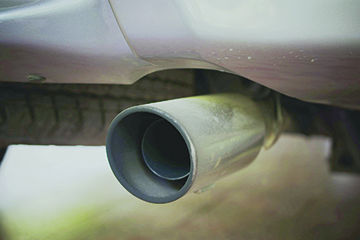
The fuel you use to drive past Suncor may have been refined in the same location.
by Suncor are literally used to take you closer to the sun.
As far as polluters go, Suncor is one of the top producers of carbon emissions with a track record of frequent malfunctions including a recent incident when an “operational upset” released a plume of yellowish debris into the air which wafted across the area and landed on outdoor surfaces throughout the district. According to an article by The Denver Post, the 89-year-old facility releases 866,100 tons of fumes per year. This has earned the surrounding communities of Globeville and Elyria-Swansea the title of “The Most Polluted Zip Code in the Nation” (80216) — according to a 2018 survey conducted by ATTOM Data Solutions.
Follow The Money
Accolades notwithstanding, Suncor’s net worth, or that of its Canadian parent company is recorded by Macrotrends.net to be at an estimated $28.18 billion.It pays $14 million (average) in annual taxes paid to Commerce City and Adams County but gets $2.3 million in tax credits the refinery receives for operating in an “enterprise zone.” The Oxford dictionary defines this as “An impoverished area in which incentives such as tax concessions are offered to encourage business investment and provide jobs for the residents.” While the title is ambiguous, the definition is spot-on. The districts surrounding the Suncor facility are some of the lowest-income areas in the region. Residents are almost universally opposed to the refinery, attributing decades of health issues to the constant presence of toxic fumes.
According to a March 2020 article by CBS4, $4 million of that settlement is allotted for penalties and community projects while $5 million is “… for Suncor to hire a third-party company to investigate why its facility continues to have problems and implement recommendations from that investigation.” So, essentially, they have to pay a fine that they reap the rewards from. They are, essentially, being forced to give concessions

Unless Denverites quit driving and flying, Suncor will not be departing anytime soon.
to the community and to fix their own problem using the money they are being “fined” for.
Old Habits Die Hard
While some are calling for the refinery to be shut down, the measure carries another hidden, ironic caveat. Were that to happen, the pipeline through which the crude oil is transported to Colorado from Alberta, Canada, would have to be replaced by diesel engines from large semi-trucks so that DIA could continue to operate. This, in turn, would create possibly even more carbon emissions than the refinery is currently generating. So, unless Denverites plan to curtail the need for air travel, gasoline and asphalt, it looks as though it’s going to be business as usual.






















